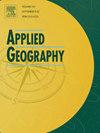Identifying and rebuilding a spatial network of wildlands to promote rewilding on the Qinghai‒Tibet Plateau
IF 4
2区 地球科学
Q1 GEOGRAPHY
引用次数: 0
Abstract
Rewilding is an emerging strategy for biodiversity conservation. The 3Cs framework for rewilding involves three key components—core areas, corridors, and carnivores—of which the first two are related to space and land. By focusing on the Qinghai‒Tibet Plateau, we identified core areas and corridors, constructing a spatial network of wildlands on the basis of suitability assessment and ecological process simulation. The network accuracy was verified with biodiversity data, and policy suggestions were proposed according to land use analysis and related adjustment costs. The results show that wilderness suitability decreases from southeast to northwest. Large core areas are in the southeast, whereas corridors traverse the northwest, connecting relatively small, scattered, and wide core areas. Although the spatial network covers 25.69 % of the total area, 56.4 % of the carnivore records and 69.88 % of the mammal records are in this area. Most land types within the network are forests and grasslands; however, certain artificial surfaces and crop lands must be adjusted to enhance connectivity. Considering the adjustment costs, nonecological lands within corridors should be prioritized for transformation. We suggest a strategy that considers the quantity, scale, and distribution of the core areas, in addition to the adjustment of nonecological lands, to improve the ability of the spatial network to effectively conserve biodiversity.
识别与重建青藏高原野地空间网络,促进青藏高原再野化
野生化是一种新兴的生物多样性保护策略。“3c”野化框架包括三个关键组成部分:核心区域、走廊和食肉动物,其中前两个与空间和土地有关。以青藏高原为研究对象,在适宜性评价和生态过程模拟的基础上,确定了核心区和廊道,构建了荒地空间网络。利用生物多样性数据验证了网络的准确性,并根据土地利用分析和相关调整成本提出了政策建议。结果表明,从东南向西北,荒野适宜性逐渐降低。大的核心区在东南部,而走廊横跨西北部,连接相对较小,分散和广泛的核心区。虽然空间网络覆盖面积占总面积的25.69%,但56.4%的食肉动物记录和69.88%的哺乳动物记录都在这一区域。网络内的大部分土地类型是森林和草原;然而,某些人造地面和农田必须进行调整,以增强连通性。考虑到调整成本,应优先对廊道内非生态用地进行改造。建议综合考虑核心区的数量、规模和分布,结合非生态用地的调整,提高空间网络有效保护生物多样性的能力。
本文章由计算机程序翻译,如有差异,请以英文原文为准。
求助全文
约1分钟内获得全文
求助全文
来源期刊

Applied Geography
GEOGRAPHY-
CiteScore
8.00
自引率
2.00%
发文量
134
期刊介绍:
Applied Geography is a journal devoted to the publication of research which utilizes geographic approaches (human, physical, nature-society and GIScience) to resolve human problems that have a spatial dimension. These problems may be related to the assessment, management and allocation of the world physical and/or human resources. The underlying rationale of the journal is that only through a clear understanding of the relevant societal, physical, and coupled natural-humans systems can we resolve such problems. Papers are invited on any theme involving the application of geographical theory and methodology in the resolution of human problems.
 求助内容:
求助内容: 应助结果提醒方式:
应助结果提醒方式:


